
A tribute act, tribute band, tribute group or tribute artist is a music group, singer, or musician who specifically plays the music of a well-known music act. Tribute acts include individual performers who mimic the songs and style of an artist, such as Elvis impersonators covering the works of Elvis Presley or groups like The Iron Maidens, an all-female band that pays tribute to Iron Maiden.
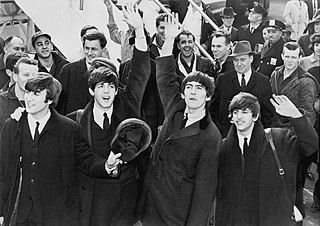
Beatlemania was the fanaticism surrounding the English rock band the Beatles from 1963 to 1966. The group's popularity grew in the United Kingdom in late 1963, propelled by the singles "Please Please Me", "From Me to You" and "She Loves You". By October, the British press adopted the term "Beatlemania" to describe the scenes of adulation that attended the band's concert performances. By 22 February 1964, the Beatles held both the number one and number two spots on the Billboard Hot 100, with "I Want to Hold Your Hand" and "She Loves You", respectively. Their world tours were characterised by the same levels of hysteria and high-pitched screaming by female fans, both at concerts and during the group's travels between venues. Commentators likened the intensity of this adulation to a religious fervour and to a female masturbation fantasy. Among the displays of deity-like worship, fans would approach the band in the belief that they possessed supernatural healing powers.
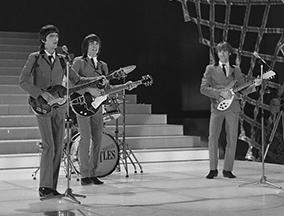
The Bootleg Beatles are a Beatles tribute band. They have performed over 4,000 times since their establishment in March 1980.
The Great American Songbook is the loosely defined canon of significant 20th-century American jazz standards, popular songs, and show tunes.
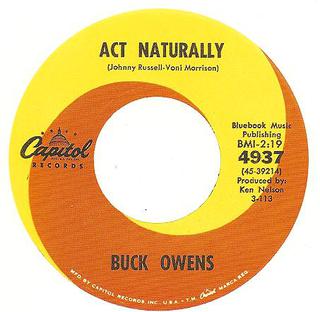
"Act Naturally" is a song written by Johnny Russell, with a writing credit given to Voni Morrison and publishing rights transferred to Buck Owens. It was originally recorded by Buck Owens and the Buckaroos, whose version reached number one on the Billboard Country Singles chart in 1963, his first chart-topper. In 2002, Shelly Fabian of About.com ranked the song number 169 on her list of the Top 500 Country Music Songs.

The Cast of Beatlemania is a U.S. Beatles' tribute band formed in 1980. The Cast is one of longest running Beatles' tribute band in the world. The group features founder Lenie Colacino, a former cast member of the 1977 Broadway hit musical Beatlemania. The group has performed in all contiguous U.S. states, and over twenty foreign countries, including Canada, England, Mexico, Central and South America, Brazil and Japan.
The Apple scruffs were a group of devoted Beatles fans who congregated outside the Apple Corps building and at the gates of Abbey Road Studios in London during the late 1960s, in the hope of seeing or interacting with one of the band members. According to Apple press officer Derek Taylor, when The Sunday Times wrote a feature article on the company in the late 1960s, their map included a location for the scruffs, on the steps of the offices at 3 Savile Row.
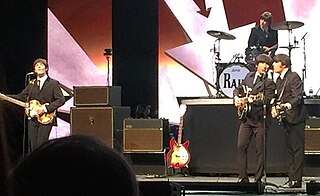
Rain: A Tribute to the Beatles, styled RAIN, is a Beatles tribute and later a theatrical production. Rain gives audiences the experience of seeing Beatles' songs performed live that were never done so by the band itself. It predates the popular Broadway show Beatlemania by several years. Rain has played Broadway, and toured for years.

The Beatles were an English rock band formed in Liverpool in 1960. With a line-up comprising John Lennon, Paul McCartney, George Harrison and Ringo Starr, they are commonly regarded as the most influential band of all time. Between 1964 and 1970, they appeared in five major motion pictures, beginning with A Hard Day's Night (1964) and ending with Let It Be (1970). From late 1965 to 1969, the group also appeared in several promotional films for their singles, which have been credited with anticipating music videos and the rise of MTV in the 1980s.
The Beatles Anthology is a documentary television series on the career of the Beatles. It was broadcast on UK television in eight parts on ITV between 26 November and 31 December 1995, while in the United States it was seen as three feature-length episodes on ABC between 19 and 23 November 1995. It was released in greatly expanded form as an eight-volume VHS set and an eight-disc LaserDisc set on 5 September 1996. The series was re-released on DVD in 2003, with an 81-minute special-features disc.
Les Fradkin is an American MIDI guitarist, keyboardist, songwriter, composer, and record producer. He is best known for being a member of the original cast of the hit Broadway show Beatlemania. In addition to playing MIDI guitar, he plays 12 string guitar, the Starr Labs Ztar, guitar synthesizer, SynthAxe, Hammond organ, Mellotron, piano, bass guitar, and Moog synthesizer.
Marty Feier is an American drummer and music producer. He is best known for his musician/producer role with 1313 Mockingbird Lane and for his work backing guitar pioneer Link Wray. He also portrayed Ringo Starr while touring worldwide with The Cast of Beatlemania.
The Beatles were originally a quartet, but only Paul McCartney and Ringo Starr remain.
David "Bruce" Spizer is a tax attorney in New Orleans, Louisiana, who is also recognized as an expert on the Beatles. He has published thirteen books, and is frequently quoted as an authority on the history of the band and its recordings.
Michael Bellusci is a drummer/musician best known for his work with the post 1984 touring company of the Broadway Musical "Beatlemania" and the bands "Strawberry Fields", "Get With It" and "Shock".
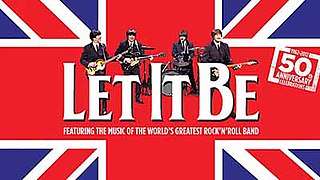
Let It Be is a West End and Broadway concert revue based on the career of English rock band, The Beatles, from 1962 to their breakup in 1970.

The Fest for Beatles Fans is a twice-annual, three-day festival that honors the lasting legacy of the Beatles. The festival takes place in the New York metropolitan area, ordinarily in March or April, and in Chicago, Illinois, each August. Running Friday through Sunday, the Fest features special guests, live concerts, exhibits, art contests, a Beatles marketplace, a sound-alike contest, a Battle of the Beatles Bands, and more.

Larry Russell is a New York City-based performing musician, recording producer, audio engineer, and composer. He achieved national recognition for his collaborations with Billy Joel.

The Beatles made several appearances on The Ed Sullivan Show, including three in February 1964 that were among their first appearances in front of an American audience. Their first appearance, on February 9, was seen by over 73 million viewers and came to be regarded as a cultural watershed that launched American Beatlemania—as well as the wider British Invasion of American pop music—and inspired many young viewers to become rock musicians. The band also made another appearance during their 1965 U.S. tour.










